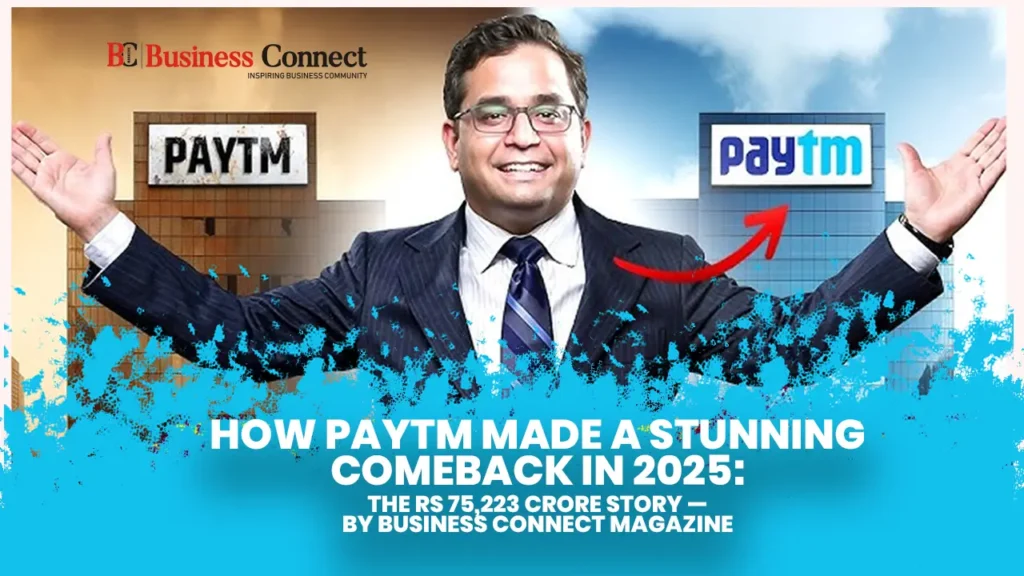How Paytm Made a Stunning Comeback in 2025: The Rs 75,223 Crore Story — By Business Connect Magazine
Written By Jaya Pathak
Context: From Stress to Stability
Paytm didn’t have a good time in 2024 with some problems in its banking business and changes in its partnerships. So, in 2025, they decided to keep things simple—fix how the company works, make their products easier, and build strong relationships. This helped them bounce back, and now people and businesses trust them again. They handled *Rs 75,223 crore* in payments, showing they’re doing well again.
Rebuilding Trust on Open Rails:
The pivot began with infrastructure. Paytm leaned into interoperable public rails and established card networks, migrated handles through sponsor banks in a staged manner, and ring‑fenced settlement flows to reduce single‑point dependencies. For merchants, QR acceptance, soundbox devices, and support channels stayed live through bank partnerships rather than captive stacks. The message to the market was clear: reliability at checkout, predictability in settlement, and accountability in support are non‑negotiable.
Governance, Risk, and agreement:
A durable comeback required institutional guardrails. The company’s board took a closer look at how data is handled, how customer identity checks (KYC/AML) are done, and how complaints are resolved. They created clear guides for managing vendor risks and handling incidents. They also improved audit records so partners could access them more easily. Instead of treating agreement as just a checkbox, they made it a key strength—this helped speed up approvals and made it easier to work with other systems. These changes helped build trust with regulators and business partners, which is essential for growing in the financial world.
Sharper Product Thesis:
On the consumer side, the app foregrounds high‑frequency use cases—UPI, cards, bill payments, transit, and ticketing—keeping discretionary modules discoverable without clutter. For merchants, the bundle is service‑led: device‑as‑a‑service, rapid settlements, reconciliation tools, and clear dispute workflows. The guiding principle is a shorter path from intent to transaction and from transaction to settlement, with fewer failure nodes and transparent recourse.
Monetization With Discipline:
Growth moved from vanity metrics to unit economics. Key contributors include:
- Subscription and rental income from soundboxes and POS devices.
- Normalized card MDR and category‑specific economics where interchange permits.
- Contextual advertising and featured placements that respect brand safety.
- Fee‑based services for balancing, chargeback handling, and settlement acceleration.
This mix diversifies revenue, aligns incentives with merchants, and cushions core payments against margin compression.
Distribution as a Moat:
Paytm’s last‑mile distribution remains difficult to replicate. Dense QR penetration, a large soundbox fleet, and on‑ground agent support compress onboarding times and reduce churn, particularly outside metros. In smaller cities and transit corridors, these assets convert directly into transaction stickiness and cross‑sell opportunities across ticketing, bill pay, and financial services sold via partner rails.
Technology That Prioritizes Resilience:
Engineering choices emphasize observability and graceful degradation. Payment orchestration routes across rails dynamically; telemetry flags failure patterns in near real time; lightweight clients maintain performance on modest Android hardware and variable networks. Security layers—tokenization, device binding, and deviation detection—operate beneath the surface to protect the edge without adding friction at the point of sale.
Reading the Rs 75,223 Crore Marker:
The Rs 75,223 crore headline functions as shorthand for operating throughput aggregated across payments and allied flows, as reflected in company and industry reporting. Its importance lies in the architecture underneath: diversified partner banks, standardized governance, disciplined monetization, and service levels that keep both sides of the marketplace engaged. Scale, in this framing, is an outcome of process reliability rather than promotional spend.
Risk Factors and Mitigants:
– Regulatory evolution: Transparent reporting, audit‑ready trails, and conservative interpretations of guidance reduce approval risk.
– Fraud and counterfeit vectors: Layered controls, device security, and rapid response teams limit loss severity and duration.
– Margin compression: Services and devices, coupled with analytics‑led merchant tooling, provide buffers when core MDR tightens.
FAQs:
1) What does the Rs 75,223 crore figure signify?
It represents a headline measure of operating throughput across payments and allied commerce flows, reflecting regained scale and process stability.
2) How did Paytm restore confidence with merchants and users?
By diversifying banking partnerships, stabilizing settlement cycles, improving dispute resolution, and keeping acceptance devices and support channels consistently available.
3) Where does monetization come from in 2025?
Subscriptions and rentals on devices, normalized card MDR, contextual advertising, and paid services such as reconciliation, chargeback support, and settlement acceleration.
4) What differentiates the current merchant proposition?
A service‑led bundle—reliable acceptance, predictable settlements, analytics, and clear recourse—that reduces friction and improves cash‑flow visibility for small and mid‑sized businesses.
5) What are the main risks ahead?
Regulatory change, evolving fraud patterns, and persistent margin pressure in core payments. Mitigants include layered controls, diversified revenue, and strict governance over integrations and data.
Add Business Connect magazine to your Google News feed
Must Read:-
- Success Story of Arattai: The Indian messaging app
- Built a Tech Empire from a Village! The Inspiring Journey of Sridhar Vembu and Zoho
- Arattai vs WhatsApp: Which Is Better for Privacy and Security?
- Snapdeal 2025: The Complete Story of India’s Famous Online Marketplace
How IndiGo Became the King of Indian Airlines: Shocking Business Model Explained



